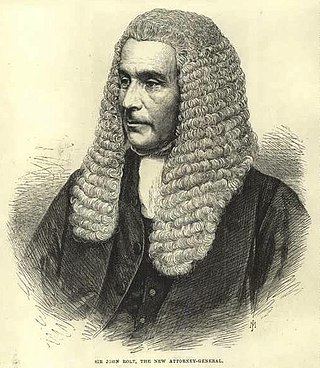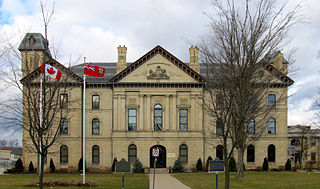
In the field of jurisprudence, equity is the particular body of law, developed in the English Court of Chancery, with the general purpose of providing legal remedies for cases wherein the common law is inflexible and cannot fairly resolve the disputed legal matter. Conceptually, equity was part of the historical origins of the system of common law of England, yet is a field of law separate from common law, because equity has its own unique rules and principles, and was administered by courts of equity.

English law is the common law legal system of England and Wales, comprising mainly criminal law and civil law, each branch having its own courts and procedures.
A writ of prohibition is a writ directing a subordinate to stop doing something the law prohibits. This writ is often issued by a superior court to the lower court directing it not to proceed with a case which does not fall under its jurisdiction.

The Court of Chancery was a court of equity in England and Wales that followed a set of loose rules to avoid a slow pace of change and possible harshness of the common law. The Chancery had jurisdiction over all matters of equity, including trusts, land law, the estates of lunatics and the guardianship of infants.

In the history of the courts of England and Wales, the Judicature Acts were a series of Acts of Parliament, beginning in the 1870s, which aimed to fuse the hitherto split system of courts of England and Wales. The first two Acts were the Supreme Court of Judicature Act 1873 and the Supreme Court of Judicature Act 1875, with a further series of amending acts.

The Exchequer of Pleas, or Court of Exchequer, was a court that dealt with matters of equity, a set of legal principles based on natural law and common law in England and Wales. Originally part of the curia regis, or King's Council, the Exchequer of Pleas split from the curia in the 1190s to sit as an independent central court. The Court of Chancery's reputation for tardiness and expense resulted in much of its business transferring to the Exchequer. The Exchequer and Chancery, with similar jurisdictions, drew closer together over the years until an argument was made during the 19th century that having two seemingly identical courts was unnecessary. As a result, the Exchequer lost its equity jurisdiction. With the Judicature Acts, the Exchequer was formally dissolved as a judicial body by an Order in Council on 16 December 1880.

A court of equity, also known as an equity court or chancery court, is a court authorized to apply principles of equity rather than principles of law to cases brought before it. These courts originated from petitions to the Lord Chancellor of England and primarily heard claims for relief other than damages, such as specific performance and extraordinary writs. Over time, most equity courts merged with courts of law, and the adoption of various Acts granted courts combined jurisdiction to administer common law and equity concurrently. Courts of equity are now recognized for complementing the common law by addressing its shortcomings and promoting justice.

The Delaware Court of Chancery is a court of equity in the U.S. state of Delaware. It is one of Delaware's three constitutional courts, along with the Supreme Court and Superior Court. Since 2018, the court consists of seven judges. The court is known for being a hub for corporate governance litigation in the United States, as two-thirds of Fortune 500 companies are incorporated in Delaware.

The Court of Chancery was a court which exercised equitable jurisdiction in Ireland until its abolition as part of the reform of the court system in 1877. It was the court in which the Lord Chancellor of Ireland presided. Its final sitting place was at the Four Courts in Dublin, which still stands.

Sir John Jervis, PC was an English lawyer, law reformer and Attorney General in the administration of Lord John Russell. He subsequently became a judge and enjoyed a career as a robust but intelligent and innovative jurist, a career cut short by his early and sudden death.

Sir John Rolt, PC was an English lawyer, Conservative politician, and judge who served as Attorney General under Lord Derby.
The Six Clerks' Office was a public legal office that served the equitable jurisdiction of the English Court of Chancery in London, England, until the mid-19th century.
The Court of Chancery of the County Palatine of Lancaster was a court of chancery that exercised jurisdiction within the County Palatine of Lancaster until it was merged with the High Court and abolished in 1972.

The Chancery Amendment Act 1858 also known as Lord Cairns' Act after Sir Hugh Cairns, was an Act of the Parliament of the United Kingdom that allowed the English Court of Chancery, the Irish Chancery and the Chancery Court of the County Palatine of Lancaster to award damages, in addition to their previous function of awarding injunctions and specific performance. The Act also made several procedural changes to the Chancery courts, most notably allowing them to call a jury, and allowed the Lord Chancellor to amend the practice regulations of the courts. By allowing the Chancery courts to award damages it narrowed the gap between the common law and equity courts and accelerated the passing of the Judicature Act 1873, and for that reason has been described by Ernest Pollock as "prophetic".

The High Court of Justice in London, known properly as His Majesty's High Court of Justice in England, together with the Court of Appeal and the Crown Court, are the Senior Courts of England and Wales. Its name is abbreviated as EWHC for legal citation purposes.
The Court of Chancery of the County Palatine of Durham and Sadberge was a court of chancery that exercised jurisdiction within the County Palatine of Durham until it was merged into the High Court in 1972.

The history of equity and trusts concerns the origin of the body of rules known as Equity, Uses, English trust law and their development into the modern body of trust law that spread with the Common law to the Commonwealth and the United States.
The Court of Pleas of the County Palatine of Durham and Sadberge, sometimes called the Court of Pleas or Common Pleas of or at Durham was a court of common pleas that exercised jurisdiction within the County Palatine of Durham until its jurisdiction was transferred to the High Court by the Supreme Court of Judicature Act 1873. Before the transfer of its jurisdiction, this tribunal was next in importance to the Chancery of Durham. The Court of Pleas probably developed from the free court of the Bishop of Durham. The Court of Pleas was clearly visible as a distinct court, separate from the Chancery, in the thirteenth century.
Certain former courts of England and Wales have been abolished or merged into or with other courts, and certain other courts of England and Wales have fallen into disuse.

Accounts of the Indigenous law governing dispute resolution in the area now called Ontario, Canada, date from the early to mid-17th century. French civil law courts were created in Canada, the colony of New France, in the 17th century, and common law courts were first established in 1764. The territory was then known as the province of Quebec.













